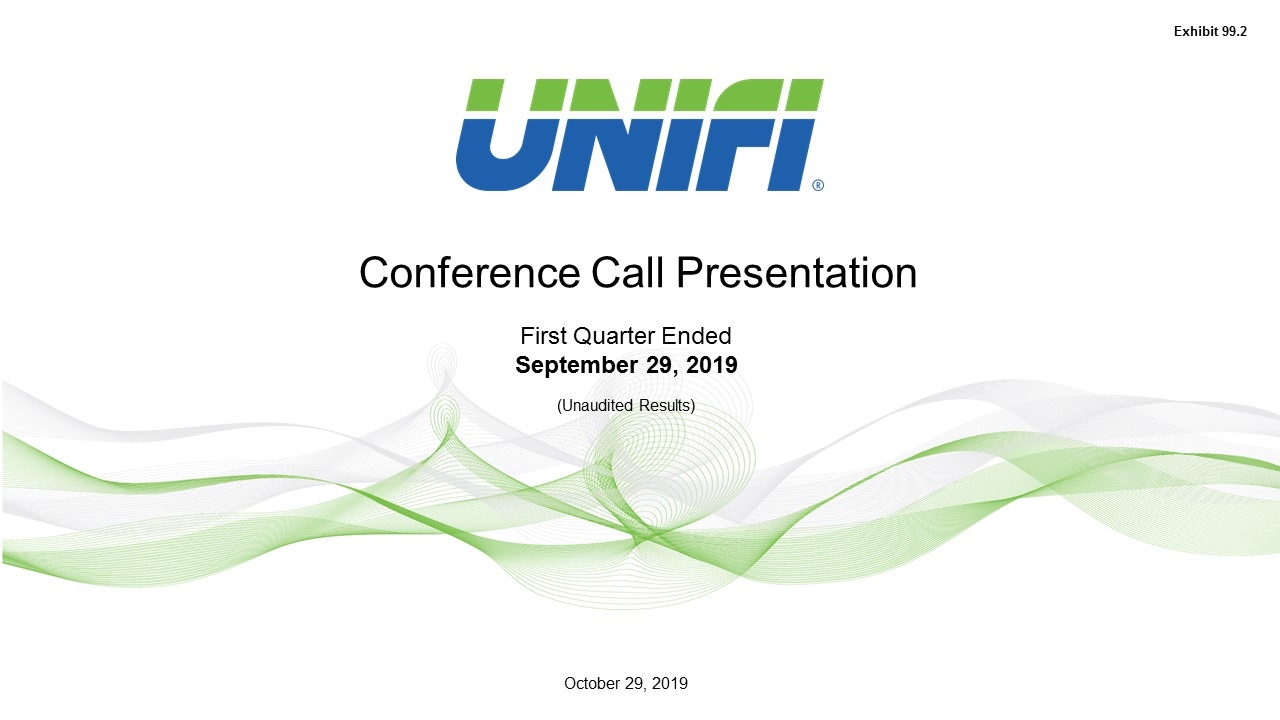
First Quarter Ended September 29, 2019 (Unaudited Results) October 29, 2019 Conference Call Presentation Exhibit 99.2
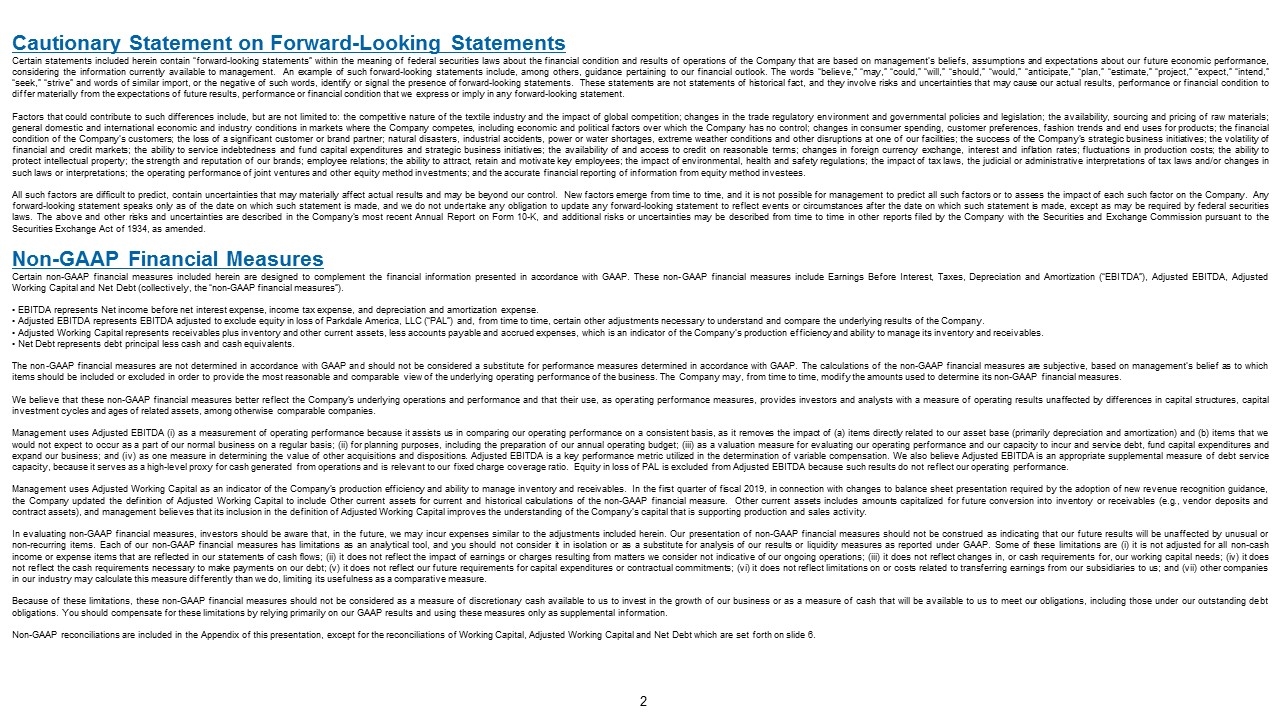
Cautionary Statement on Forward-Looking Statements Certain statements included herein contain “forward-looking statements” within the meaning of federal securities laws about the financial condition and results of operations of the Company that are based on management’s beliefs, assumptions and expectations about our future economic performance, considering the information currently available to management. An example of such forward-looking statements include, among others, guidance pertaining to our financial outlook. The words “believe,” “may,” “could,” “will,” “should,” “would,” “anticipate,” “plan,” “estimate,” “project,” “expect,” “intend,” “seek,” “strive” and words of similar import, or the negative of such words, identify or signal the presence of forward-looking statements. These statements are not statements of historical fact, and they involve risks and uncertainties that may cause our actual results, performance or financial condition to differ materially from the expectations of future results, performance or financial condition that we express or imply in any forward-looking statement. Factors that could contribute to such differences include, but are not limited to: the competitive nature of the textile industry and the impact of global competition; changes in the trade regulatory environment and governmental policies and legislation; the availability, sourcing and pricing of raw materials; general domestic and international economic and industry conditions in markets where the Company competes, including economic and political factors over which the Company has no control; changes in consumer spending, customer preferences, fashion trends and end uses for products; the financial condition of the Company’s customers; the loss of a significant customer or brand partner; natural disasters, industrial accidents, power or water shortages, extreme weather conditions and other disruptions at one of our facilities; the success of the Company’s strategic business initiatives; the volatility of financial and credit markets; the ability to service indebtedness and fund capital expenditures and strategic business initiatives; the availability of and access to credit on reasonable terms; changes in foreign currency exchange, interest and inflation rates; fluctuations in production costs; the ability to protect intellectual property; the strength and reputation of our brands; employee relations; the ability to attract, retain and motivate key employees; the impact of environmental, health and safety regulations; the impact of tax laws, the judicial or administrative interpretations of tax laws and/or changes in such laws or interpretations; the operating performance of joint ventures and other equity method investments; and the accurate financial reporting of information from equity method investees. All such factors are difficult to predict, contain uncertainties that may materially affect actual results and may be beyond our control. New factors emerge from time to time, and it is not possible for management to predict all such factors or to assess the impact of each such factor on the Company. Any forward-looking statement speaks only as of the date on which such statement is made, and we do not undertake any obligation to update any forward-looking statement to reflect events or circumstances after the date on which such statement is made, except as may be required by federal securities laws. The above and other risks and uncertainties are described in the Company’s most recent Annual Report on Form 10-K, and additional risks or uncertainties may be described from time to time in other reports filed by the Company with the Securities and Exchange Commission pursuant to the Securities Exchange Act of 1934, as amended. Non-GAAP Financial Measures Certain non-GAAP financial measures included herein are designed to complement the financial information presented in accordance with GAAP. These non-GAAP financial measures include Earnings Before Interest, Taxes, Depreciation and Amortization (“EBITDA”), Adjusted EBITDA, Adjusted Working Capital and Net Debt (collectively, the “non-GAAP financial measures”). • EBITDA represents Net income before net interest expense, income tax expense, and depreciation and amortization expense. • Adjusted EBITDA represents EBITDA adjusted to exclude equity in loss of Parkdale America, LLC (“PAL”) and, from time to time, certain other adjustments necessary to understand and compare the underlying results of the Company. • Adjusted Working Capital represents receivables plus inventory and other current assets, less accounts payable and accrued expenses, which is an indicator of the Company’s production efficiency and ability to manage its inventory and receivables. • Net Debt represents debt principal less cash and cash equivalents. The non-GAAP financial measures are not determined in accordance with GAAP and should not be considered a substitute for performance measures determined in accordance with GAAP. The calculations of the non-GAAP financial measures are subjective, based on management’s belief as to which items should be included or excluded in order to provide the most reasonable and comparable view of the underlying operating performance of the business. The Company may, from time to time, modify the amounts used to determine its non-GAAP financial measures. We believe that these non-GAAP financial measures better reflect the Company’s underlying operations and performance and that their use, as operating performance measures, provides investors and analysts with a measure of operating results unaffected by differences in capital structures, capital investment cycles and ages of related assets, among otherwise comparable companies. Management uses Adjusted EBITDA (i) as a measurement of operating performance because it assists us in comparing our operating performance on a consistent basis, as it removes the impact of (a) items directly related to our asset base (primarily depreciation and amortization) and (b) items that we would not expect to occur as a part of our normal business on a regular basis; (ii) for planning purposes, including the preparation of our annual operating budget; (iii) as a valuation measure for evaluating our operating performance and our capacity to incur and service debt, fund capital expenditures and expand our business; and (iv) as one measure in determining the value of other acquisitions and dispositions. Adjusted EBITDA is a key performance metric utilized in the determination of variable compensation. We also believe Adjusted EBITDA is an appropriate supplemental measure of debt service capacity, because it serves as a high-level proxy for cash generated from operations and is relevant to our fixed charge coverage ratio. Equity in loss of PAL is excluded from Adjusted EBITDA because such results do not reflect our operating performance. Management uses Adjusted Working Capital as an indicator of the Company’s production efficiency and ability to manage inventory and receivables. In the first quarter of fiscal 2019, in connection with changes to balance sheet presentation required by the adoption of new revenue recognition guidance, the Company updated the definition of Adjusted Working Capital to include Other current assets for current and historical calculations of the non-GAAP financial measure. Other current assets includes amounts capitalized for future conversion into inventory or receivables (e.g., vendor deposits and contract assets), and management believes that its inclusion in the definition of Adjusted Working Capital improves the understanding of the Company’s capital that is supporting production and sales activity. In evaluating non-GAAP financial measures, investors should be aware that, in the future, we may incur expenses similar to the adjustments included herein. Our presentation of non-GAAP financial measures should not be construed as indicating that our future results will be unaffected by unusual or non-recurring items. Each of our non-GAAP financial measures has limitations as an analytical tool, and you should not consider it in isolation or as a substitute for analysis of our results or liquidity measures as reported under GAAP. Some of these limitations are (i) it is not adjusted for all non-cash income or expense items that are reflected in our statements of cash flows; (ii) it does not reflect the impact of earnings or charges resulting from matters we consider not indicative of our ongoing operations; (iii) it does not reflect changes in, or cash requirements for, our working capital needs; (iv) it does not reflect the cash requirements necessary to make payments on our debt; (v) it does not reflect our future requirements for capital expenditures or contractual commitments; (vi) it does not reflect limitations on or costs related to transferring earnings from our subsidiaries to us; and (vii) other companies in our industry may calculate this measure differently than we do, limiting its usefulness as a comparative measure. Because of these limitations, these non-GAAP financial measures should not be considered as a measure of discretionary cash available to us to invest in the growth of our business or as a measure of cash that will be available to us to meet our obligations, including those under our outstanding debt obligations. You should compensate for these limitations by relying primarily on our GAAP results and using these measures only as supplemental information. Non-GAAP reconciliations are included in the Appendix of this presentation, except for the reconciliations of Working Capital, Adjusted Working Capital and Net Debt which are set forth on slide 6.
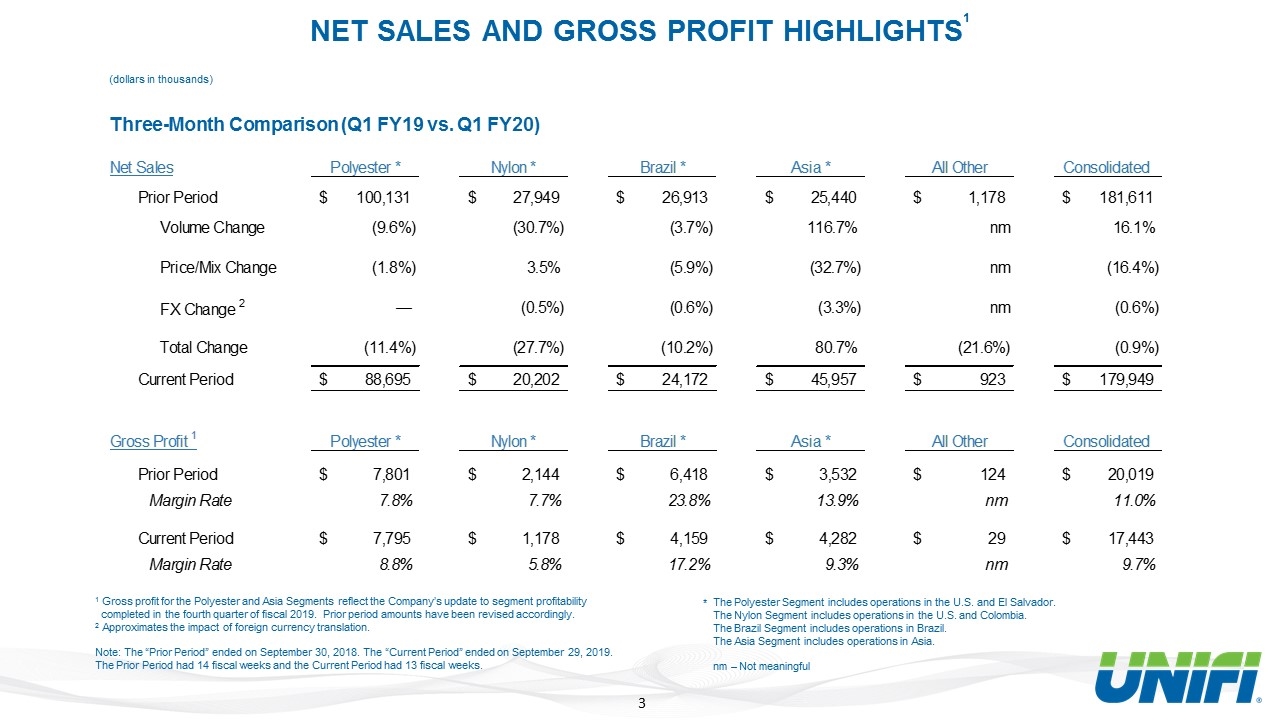
NET SALES AND GROSS PROFIT HIGHLIGHTS1 (dollars in thousands) Three-Month Comparison (Q1 FY19 vs. Q1 FY20) 1 Gross profit for the Polyester and Asia Segments reflect the Company’s update to segment profitability completed in the fourth quarter of fiscal 2019. Prior period amounts have been revised accordingly. 2 Approximates the impact of foreign currency translation. Note: The “Prior Period” ended on September 30, 2018. The “Current Period” ended on September 29, 2019. The Prior Period had 14 fiscal weeks and the Current Period had 13 fiscal weeks. The Polyester Segment includes operations in the U.S. and El Salvador. The Nylon Segment includes operations in the U.S. and Colombia. The Brazil Segment includes operations in Brazil. The Asia Segment includes operations in Asia. nm – Not meaningful *
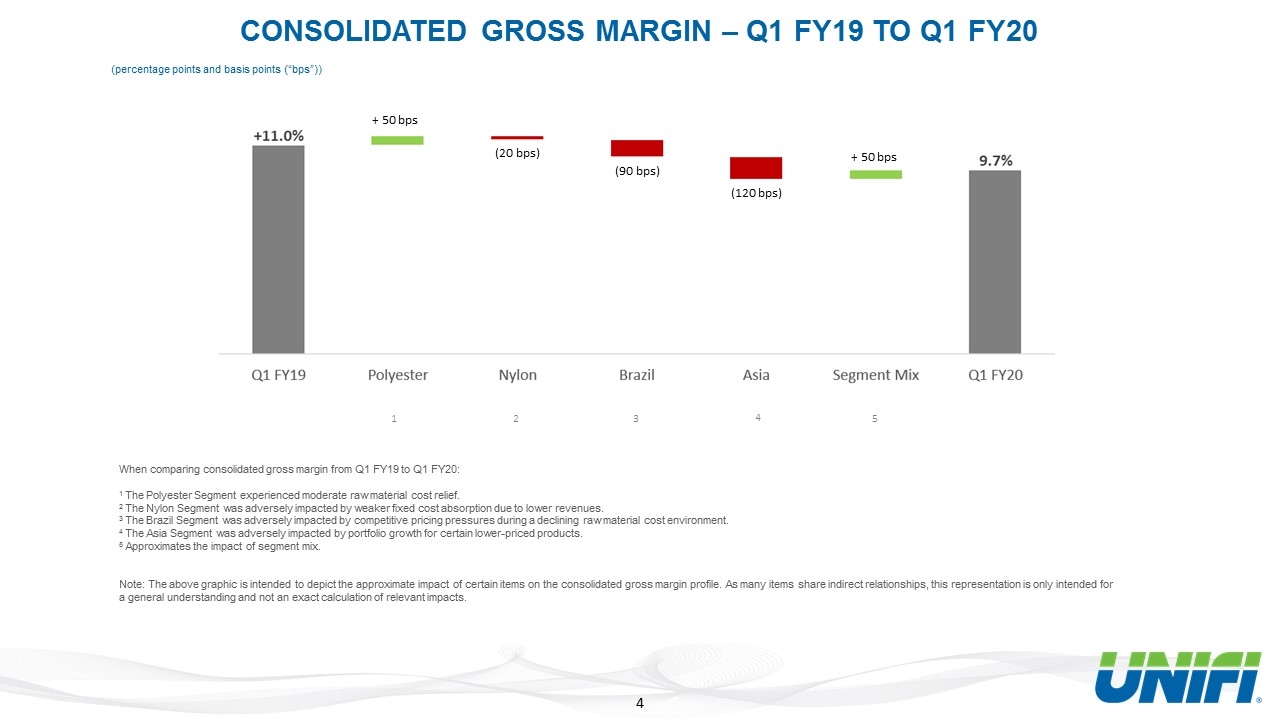
CONSOLIDATED GROSS MARGIN – Q1 FY19 TO Q1 FY20 When comparing consolidated gross margin from Q1 FY19 to Q1 FY20: 1 The Polyester Segment experienced moderate raw material cost relief. 2 The Nylon Segment was adversely impacted by weaker fixed cost absorption due to lower revenues. 3 The Brazil Segment was adversely impacted by competitive pricing pressures during a declining raw material cost environment. 4 The Asia Segment was adversely impacted by portfolio growth for certain lower-priced products. 5 Approximates the impact of segment mix. Note: The above graphic is intended to depict the approximate impact of certain items on the consolidated gross margin profile. As many items share indirect relationships, this representation is only intended for a general understanding and not an exact calculation of relevant impacts. (percentage points and basis points (“bps”)) 1 2 3 4 5 + 50 bps (20 bps) (90 bps) (120 bps) + 50 bps
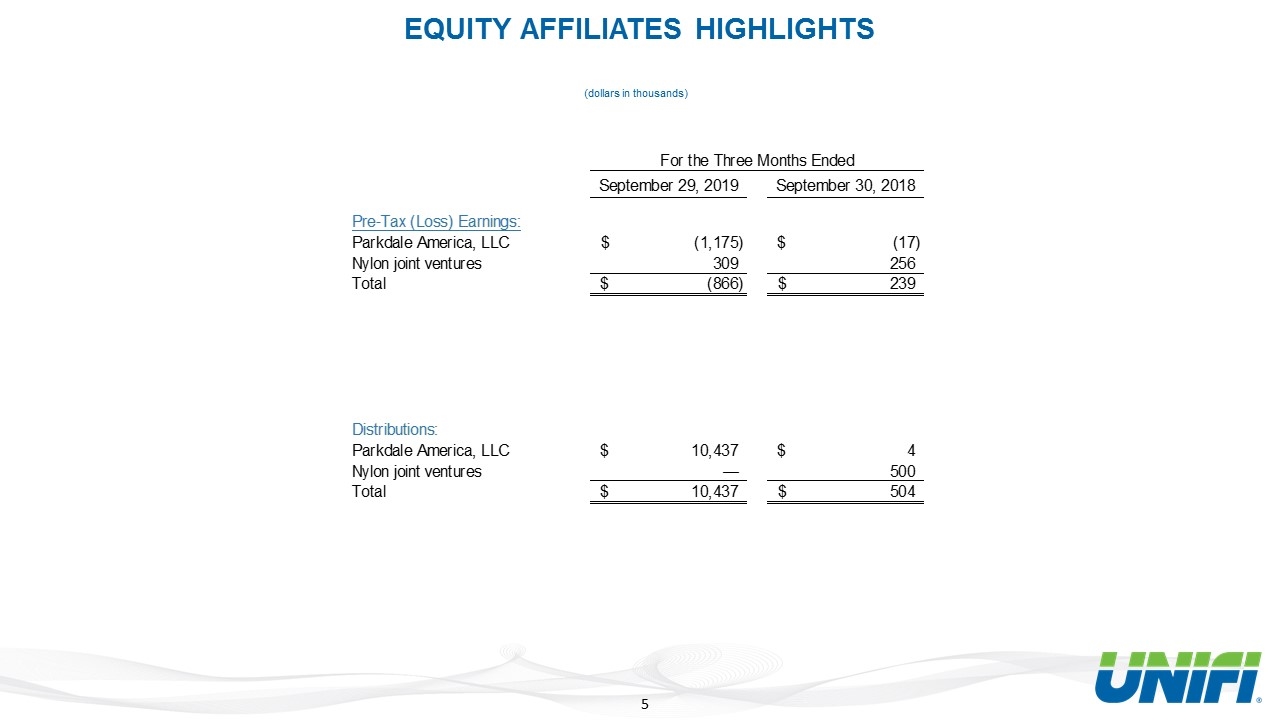
EQUITY AFFILIATES HIGHLIGHTS (dollars in thousands)
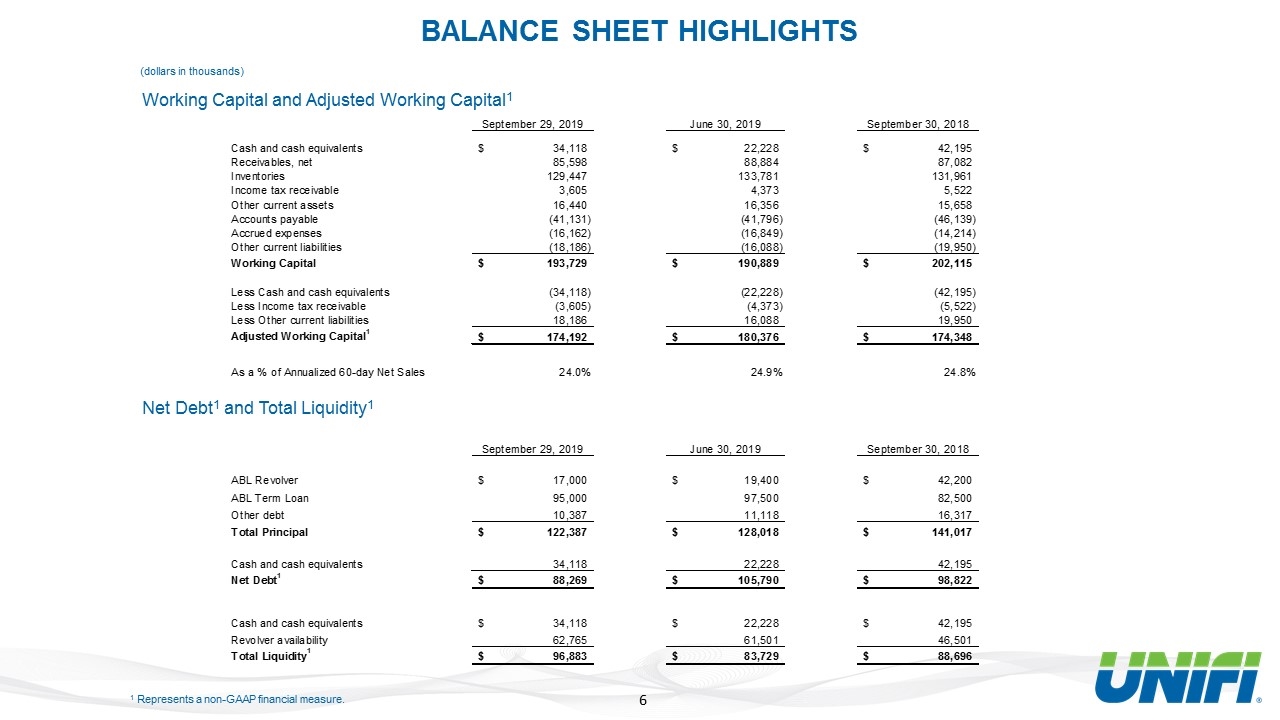
BALANCE SHEET HIGHLIGHTS (dollars in thousands) Working Capital and Adjusted Working Capital1 Net Debt1 and Total Liquidity1 1 Represents a non-GAAP financial measure.
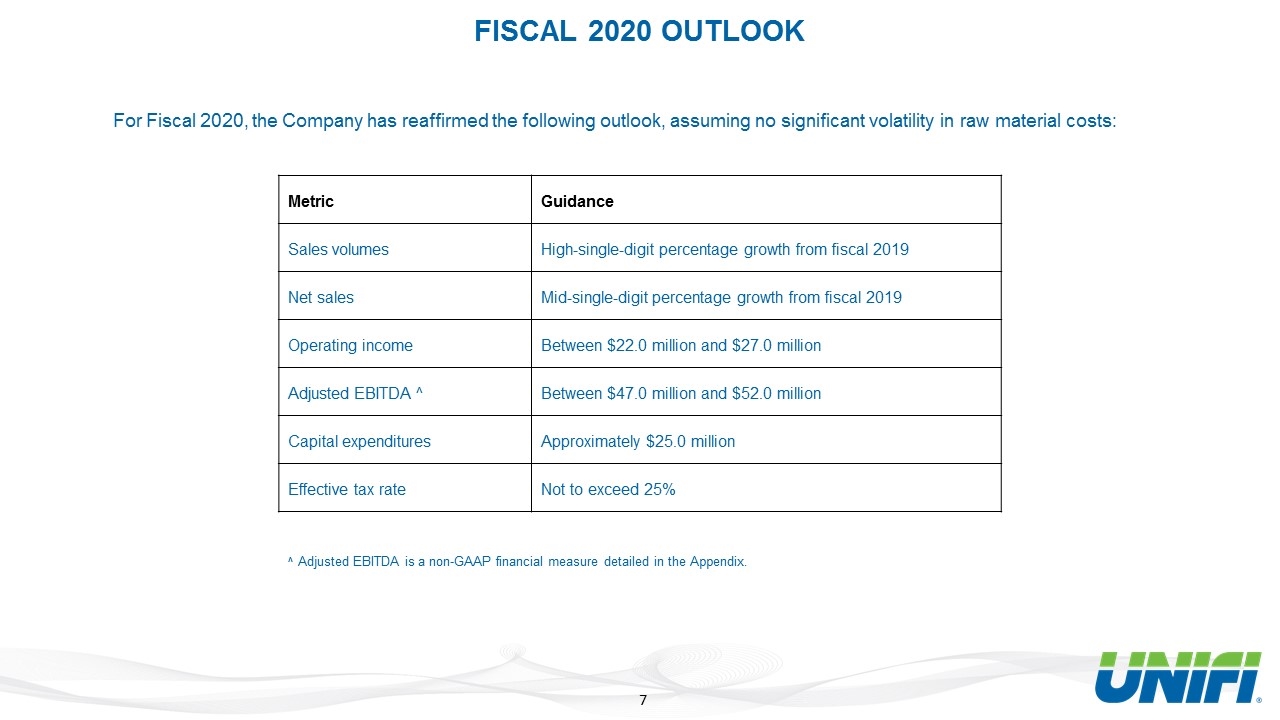
For Fiscal 2020, the Company has reaffirmed the following outlook, assuming no significant volatility in raw material costs: Metric Guidance Sales volumes High-single-digit percentage growth from fiscal 2019 Net sales Mid-single-digit percentage growth from fiscal 2019 Operating income Between $22.0 million and $27.0 million Adjusted EBITDA ^ Between $47.0 million and $52.0 million Capital expenditures Approximately $25.0 million Effective tax rate Not to exceed 25% ^ Adjusted EBITDA is a non-GAAP financial measure detailed in the Appendix. FISCAL 2020 OUTLOOK

APPENDIX
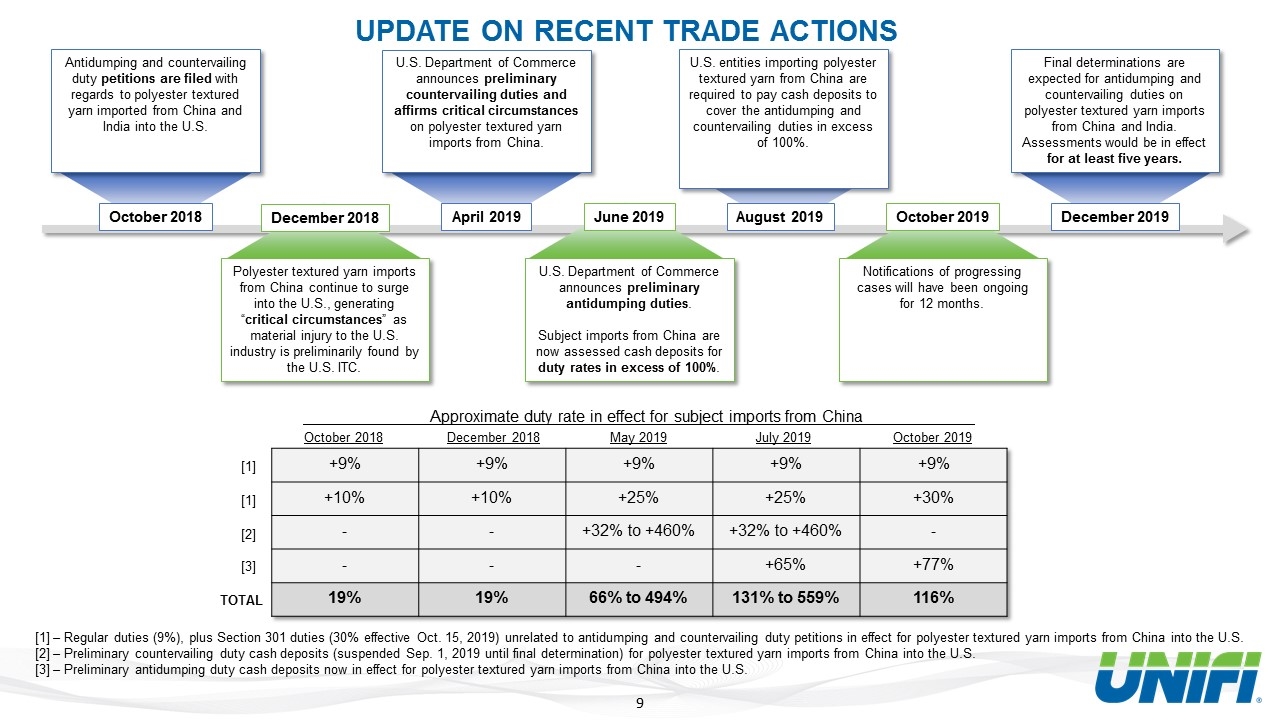
UPDATE ON RECENT TRADE ACTIONS Antidumping and countervailing duty petitions are filed with regards to polyester textured yarn imported from China and India into the U.S. U.S. Department of Commerce announces preliminary countervailing duties and affirms critical circumstances on polyester textured yarn imports from China. U.S. entities importing polyester textured yarn from China are required to pay cash deposits to cover the antidumping and countervailing duties in excess of 100%. Final determinations are expected for antidumping and countervailing duties on polyester textured yarn imports from China and India. Assessments would be in effect for at least five years. Polyester textured yarn imports from China continue to surge into the U.S., generating “critical circumstances” as material injury to the U.S. industry is preliminarily found by the U.S. ITC. U.S. Department of Commerce announces preliminary antidumping duties. Subject imports from China are now assessed cash deposits for duty rates in excess of 100%. Notifications of progressing cases will have been ongoing for 12 months. December 2018 June 2019 October 2019 Approximate duty rate in effect for subject imports from China +9% +9% +9% +9% +9% +10% +10% +25% +25% +30% - - +32% to +460% +32% to +460% - - - - +65% +77% 19% 19% 66% to 494% 131% to 559% 116% [1] [1] [1] – Regular duties (9%), plus Section 301 duties (30% effective Oct. 15, 2019) unrelated to antidumping and countervailing duty petitions in effect for polyester textured yarn imports from China into the U.S. [2] – Preliminary countervailing duty cash deposits (suspended Sep. 1, 2019 until final determination) for polyester textured yarn imports from China into the U.S. [3] – Preliminary antidumping duty cash deposits now in effect for polyester textured yarn imports from China into the U.S. [2] [3] TOTAL October 2018 April 2019 August 2019 December 2019 October 2018 December 2018 May 2019 July 2019 October 2019
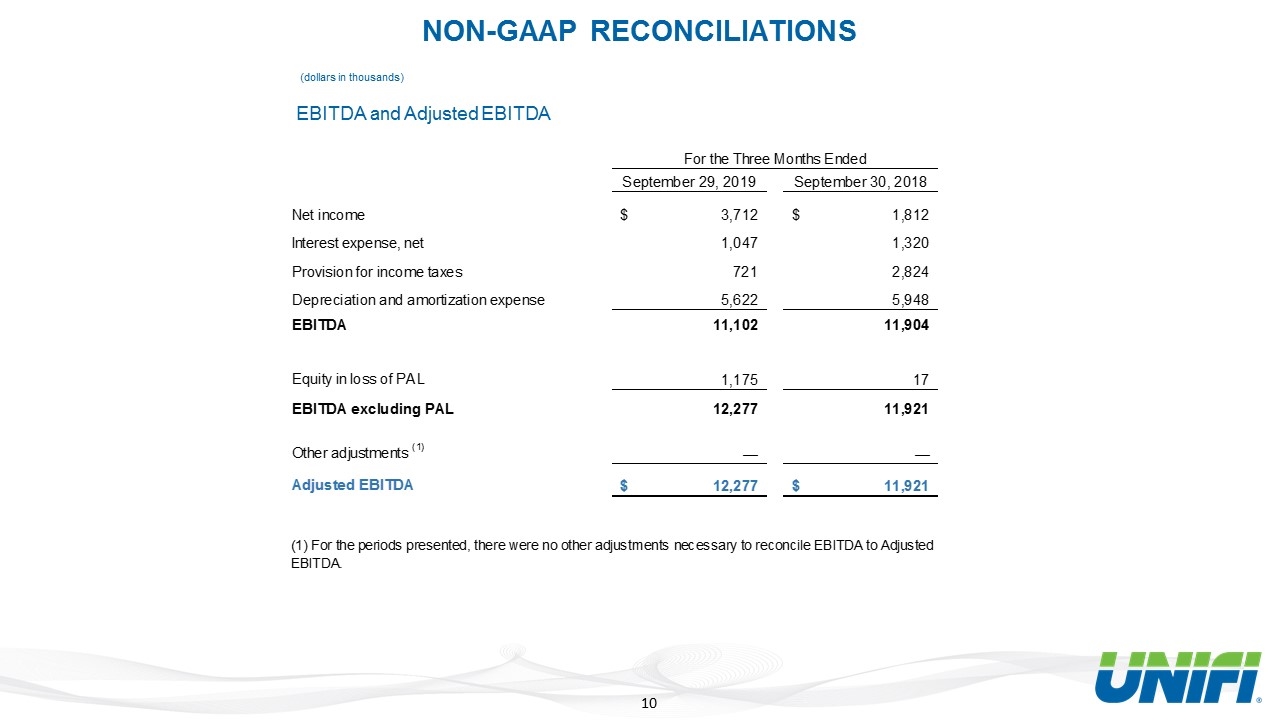
NON-GAAP RECONCILIATIONS (dollars in thousands) EBITDA and Adjusted EBITDA
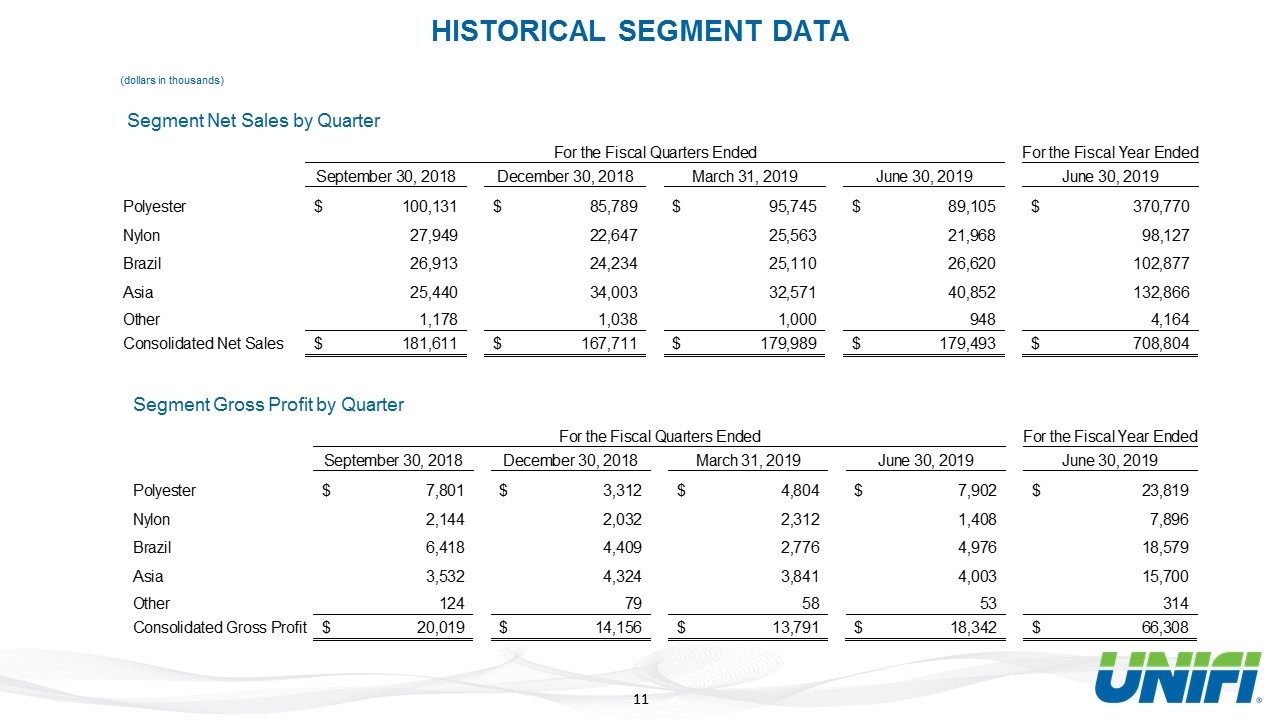
HISTORICAL SEGMENT DATA (dollars in thousands) Segment Net Sales by Quarter Segment Gross Profit by Quarter

Thank You!











